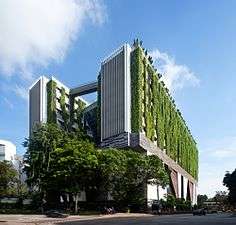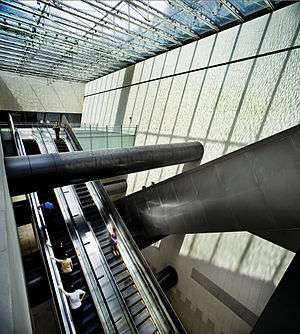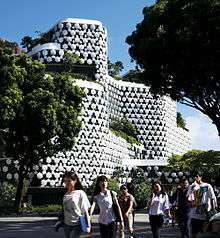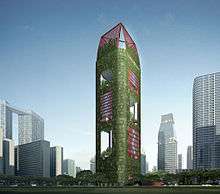WOHA
WOHA is a Singapore-based architecture practice, established in 1994 by Wong Mun Summ (born 18 August 1962) and Richard Hassell (born 28 October 1966). Its name is derived from the initial letters of the founders’ surnames. They have built over fifty projects throughout Southeast Asia, China and Australia, including residential towers, public housing estates, mass transit stations, hotels and cultural institutions.
| WOHA | |
|---|---|
 Left: Richard Hassell Right: Wong Mun Summ | |
| Practice information | |
| Key architects | Wong Mun Summ Richard Hassell |
| Founded | 1994 |
| Location | Singapore |







Their work incorporates sustainable design strategies as a response to climate change and widespread urbanization.[1] They aim to integrate landscape, architecture and urbanism in high-rise buildings to improve quality of life for residents in high-density megacities.[2] Their buildings are notable for their extensive use of natural vegetation as a building element.[3] In 2007, they came to international attention when the Moulmein Rise Residential Building in Singapore was awarded the Aga Khan Award for Architecture, establishing their reputation as designers of sustainable, naturally ventilated skyscrapers for an urban tropical context.[4]
In addition to architectural practice, WOHA have taught at the National University of Singapore[5] and both Hassell and Wong have lectured at universities around the world.[6][7][8]
History
In 1989, Wong graduated from the National University of Singapore and Hassell from the University of Western Australia. As students, both studied environmental design with an emphasis on passive design strategies and energy efficiency.[9] Wong and Hassell met while employed at Kerry Hill Architects in Singapore before founding their own practice in 1994.[10][9] WOHA’s practice begun with small projects and private houses.[9] Following their success in the open competitions for two Mass Rapid Transit (MRT) stations in Singapore in 2000 (Bras Basah MRT station and Stadium MRT station) and the commission for the 1 Moulmein Rise condominium complex, the firm shifted its focus to public and commercial architecture.[11]
According to the architects, a defining moment in the development of their design approach came with the entry for the Duxton Plain Public Housing International Competition held by Singapore’s Urban Redevelopment Authority in 2001.[9] Although WOHA’s entry was not selected for construction, it was awarded the Merit Prize and provided them with an opportunity to experiment with design strategies for environmentally and socially sustainable high-density developments that would inform their later work.[12]
WOHA subsequently completed a number of high-rises and large public buildings that were designed to be sustainable for tropical climates. These were open permeable buildings that encouraged natural ventilation to reduce reliance on mechanical cooling.[13][6] They were also characterized by the extensive use of planting to cool the structure through transpiration. It is an approach the architects have described as “breathing architecture”.[13]
Examples include the Newton Suites condominium complex in Singapore, completed in 2007,[14] the Singapore School of the Arts and The Met residential tower in Bangkok, both completed in 2009. The Met raised the international profile of the firm outside of South-East Asia, winning international awards such as the 2010 International Highrise Award and 2011 RIBA Lubetkin Award.[15][16][17] The building was characterized as an example of sustainable high-density development for tropical megacities.[18][19] The RIBA jury noted that the building offered an alternative to glazed skyscrapers common in temperate climates and made clear “that an alternative strategy to the sleek air-conditioned box can work in the tropics and has implications everywhere.”[16]
WOHA have experimented with developing new types of green skyscraper.[20] The Parkroyal on Pickering, completed in 2013, incorporates 15,000 square meters of elevated terraced gardens, which the architects refer to as “sky gardens”.[3] The Oasia Hotel Downtown, completed in 2016, features a façade of aluminum mesh that supports 21 species of plants.[21] The vertical landscaping of these structures is intended to reintroduce greenery to the built environment and encourage urban bio-diversity by attracting local birds and insects.[22]
The SkyVille @ Dawson public housing estate, completed in 2015, provided the architects with an opportunity to realize many of their ideas about housing, which were first articulated with the Duxton Plains competition.[23] According to the architects, SkyVille @ Dawson incorporates design strategies that are intended to promote community living. Communal terraces are provided every eleven stories in order to create groupings of 80 homes, referred to as “Sky Villages.” The building’s rooftop contains a publicly accessible park.[24][25]
The scale of WOHA’s built and proposed housing projects is intended to respond to the population growth of Asian cities.[26] It is also an outcome of Singapore’s constrained geographic area.[9] Wong has stated that the goal of WOHA’s architecture is to create “comfortable garden suburb experience and then replicate it vertically through a megastructure for everyone to enjoy.”[9] WOHA present their high-density housing designs as replicable models for urban development. However, critics have questioned the universal applicability of this model outside of Singapore’s communitarian political system and coordinated urban planning program.[27]
At the 2016 Venice Architecture Biennale, WOHA launched a book called Garden City Mega City, written in collaboration with Patrick Bingham-Hall.[2] The book outlines WOHA’s design strategies in the context of the threats posed by global warming and the pace of Asian urbanization.[28] WOHA currently have buildings under construction in Singapore, Indonesia, Australia, Bangladesh, India and China.
In 2017 they created the brand WOHAbeing for high-end homeware in partnership with pt:Wewood - Portuguese Joinery, Industry+, WonderGlass, Apaiser and The Rug Maker.[29]
In August 2019, WOHA was picked by URA as the designer of Singapore's Pavilion for World Expo 2020 in Dubai. The team is tasked to create a green oasis on a 1,550 square-meter site in the Expo's Sustainability District.[30]
In July 2020, a team led by Woha Architects was awarded the project to redevelop the Marina Bay floating platform.[31]
Awards
- 2018 World Architecture Festival, Building of the Year, Kampung Admiralty, Singapore[32]
- 2011 RIBA Lubetkin Prize – The Met[33]
- 2011 Australian Institute of Architects, Jørn Utzon Award for International Architecture – School of the Arts, Singapore[34]
- 2011 Singapore President's Design Award, Design of the Year – School of the Arts, Singapore
- 2010 The International Highrise Award – The Met[35]
- 2010 World Architecture Festival, World Holiday Building of the Year – Alila Villas Uluwatu[36]
- 2010 World Architecture Festival, World Learning Building of the Year – School of the Arts, Singapore[37]
- 2009 World Architecture Festival, World Transport Building of the Year – Bras Basah MRT station[38]
- 2009 World Architecture Festival, World Housing Development of the Year – The Met[39]
- 2007 Aga Khan Award for Architecture – 1 Moulmein Rise[40]
Significant Built Works
- Sky Green, Taichung, Taiwan, 2015 - 2019[41]
- Design Orchard, Singapore, 2017 - 2019
- Kampung Admiralty, Singapore, 2014 - 2017
- Parkroyal on Pickering, Singapore, 2010-2013
- School of the Arts, Singapore, 2005-2010
- Bugis+ (formerly known as iluma), Singapore, 2005-2009
- The Pano, Bangkok, Thailand, 2004-2009
- The Met, Bangkok, Thailand, 2003-2010
- Newton Suites, Singapore, 2003-2007
- Bras Basah MRT station, Singapore, 2000-2008
- Stadium MRT station, Singapore, 2000-2008
- Church of St Mary of the Angels, Singapore, 1999-2003
Further reading
- GARDEN CITY MEGA CITY: Rethinking Cities for the Age of Global Warming, Patrick Bingham-Hall, Pesaro Publishing, 2016, ISBN 978-981442806-4
- WOHA Selected Projects: Selected Projects Vol. 2, Patrick Bingham-Hall, Pesaro Publishing, 2015, ISBN 978-981-4428-04-0
- WOHA Selected Projects: Selected Projects Vol. 1, Patrick Bingham-Hall, Pesaro Publishing, 2011, ISBN 978-1-877015-30-4
- WOHA: Breathing Architecture, Prestel Verlag, 2011, ISBN 978-3-7913-5186-5
- WOHA: The Architecture of WOHA, Pesaro Publishing, 2009, ISBN 978-1-877015-16-8
References
- "Finding sustainability in a rapidly growing metropolis". Retrieved 1 March 2017.
- "WOHA". Retrieved 1 March 2017.
- Hucal, Sarah (29 July 2016). "How an architecture firm is greening Singapore's urban core". Retrieved 1 March 2017.
- "Moulmein Rise Residential Building | Aga Khan Development Network". www.akdn.org.
- "NUS - National University of Singapore". Retrieved 1 March 2017.
- ""Breathing Architecture" lecture by leading international architect Richard Hassell - University News : The University of Western Australia". Retrieved 1 March 2017.
- Harvard GSD (17 November 2015). "Wong Mun Summ and Richard Hassell of WOHA, "Garden City, Mega City..."". Retrieved 1 March 2017 – via YouTube.
- "European – South East Asian Architectural Dialogue". Archived from the original on 4 February 2017. Retrieved 1 March 2017.
- "Interview with WOHA: "The Only Way to Preserve Nature is to Integrate it into Our Built Environment"". 25 November 2016. Retrieved 1 March 2017.
- Leon Van Schaik, "WOHA: A Reflective Introduction" in WOHA: The architecture of WOHA, Anna Johnson (ed.) p. 19
- Patrick Bingham-Hall, WOHA Selected Projects: Selected Projects Vol. 1, Singapore, Sydney: Pesaro Publishing, 2011, pp. 29 – 30
- Patrick Bingham-Hall, WOHA Selected Projects: Selected Projects Vol. 1, Singapore, Sydney: Pesaro Publishing, 2011, p. 32
- "Update: WOHA's 'Breathing Architecture' Exhibition". 22 March 2012. Retrieved 1 March 2017.
- "Newton Suites, Singapore". Retrieved 1 March 2017.
- "INTERNATIONAL HIGHRISE AWARD". Archived from the original on 4 February 2017. Retrieved 1 March 2017.
- "Archived copy". Archived from the original on 2017-02-04. Retrieved 2017-02-15.CS1 maint: archived copy as title (link)
- "The Met Tower - Aga Khan Development Network". Retrieved 1 March 2017.
- "11 designers and designs recognised for outstanding achievements at the President's Design Award 2009". Retrieved 1 March 2017.
- "WOHA: Met Tower - News - Domus". Retrieved 1 March 2017.
- Sisson, Patrick (16 May 2016). "Tower as Trellis: A Plant-Covered High-Rise Reimagines Tropical Buildings". Retrieved 1 March 2017.
- "Oasia Hotel Downtown / WOHA". 6 December 2016. Retrieved 1 March 2017.
- "WOHA's parkroyal hotel features curved high rise gardens". 1 September 2013. Retrieved 1 March 2017.
- Patrick Bingham-Hall, WOHA Selected Projects: Selected Projects Vol. 1, Singapore, Sydney: Pesaro Publishing, 2011, p. 35
- "SkyVille / WOHA". 8 December 2016. Retrieved 1 March 2017.
- Magazine, Wallpaper* (23 April 2015). "Building blocks: Singapore's Dawson development gears up for completion - Architecture - Wallpaper* Magazine". Retrieved 1 March 2017.
- Patrick Bingham-Hall, GARDEN CITY MEGA CITY: Rethinking Cities for the Age of Global Warming, Singapore, Sydney: Pesaro Publishing, 2016, p.12 – 13
- "Unsociable and Unsustainable". 5 December 2016. Retrieved 1 March 2017.
- "Garden City Mega City: Rethinking Cities for the Age of Global Warming 2016". 4 August 2016. Retrieved 1 March 2017.
- Singaporean Design Brand WOHAbeing Creates High-End Homeware Made In Asia And Europe. 25 MAY 2018.
- "Singapore is planning to build a green oasis in Dubai". CNN Style. 29 August 2019.
- "Tender awarded for floating platform project". Straits Times. 16 July 2020.
- Goh, Yan Han (2 December 2018). "Kampung Admiralty snags top accolade at World Architecture Festival". The Straits Times. Retrieved 4 December 2018.
- "404". Archived from the original on 2 March 2017. Retrieved 1 March 2017.
- "School of the Arts, Singapore". Retrieved 1 March 2017.
- http://www.international-highrise-award.com/en/index2.html
- "Archived copy". Archived from the original on 2013-11-05. Retrieved 2013-07-11.CS1 maint: archived copy as title (link)
- "Archived copy". Archived from the original on 2013-04-19. Retrieved 2013-07-11.CS1 maint: archived copy as title (link)
- "Archived copy". Archived from the original on February 20, 2012. Retrieved October 11, 2013.CS1 maint: archived copy as title (link)
- "Archived copy". Archived from the original on 2012-02-20. Retrieved 2013-07-06.CS1 maint: archived copy as title (link)
- "2007 Cycle - Aga Khan Development Network". Archived from the original on 13 April 2016. Retrieved 1 March 2017.
- "WOHA populates 'sky green' development in taiwan with trees and plants on every level". Designboom.
External links
| Wikimedia Commons has media related to WOHA. |